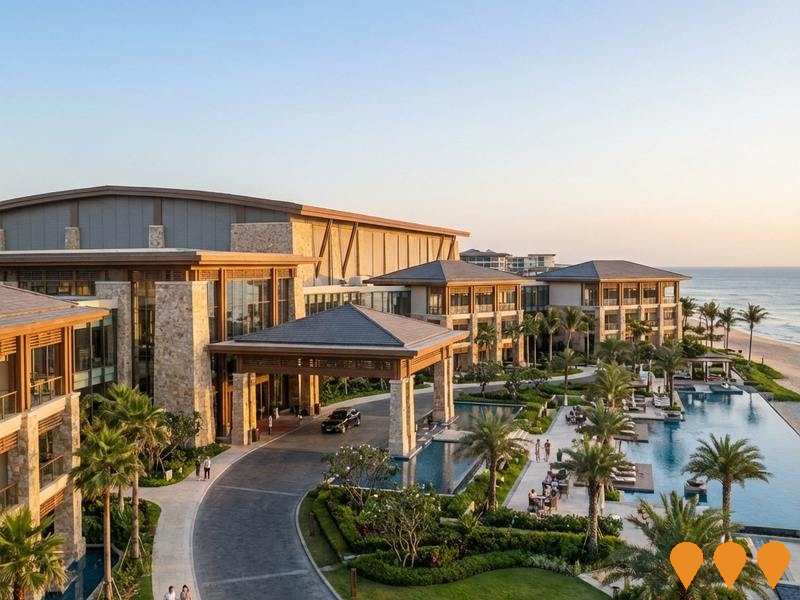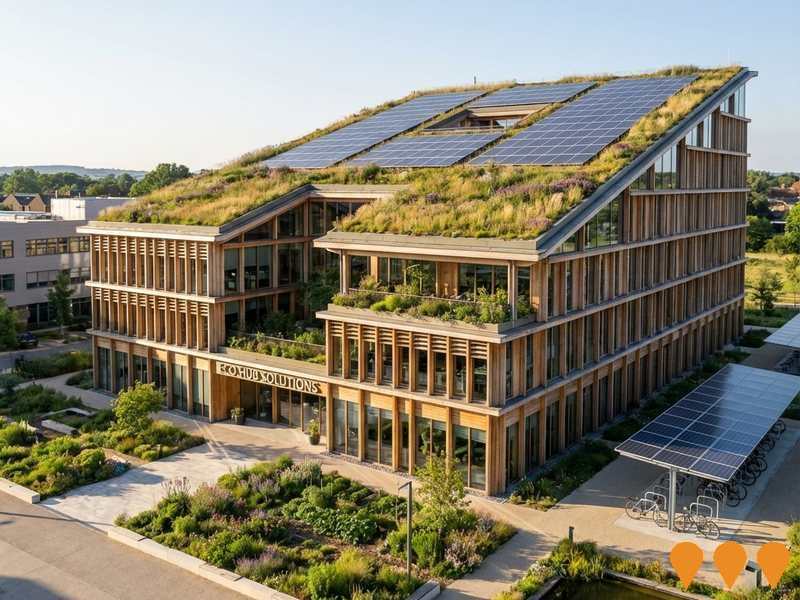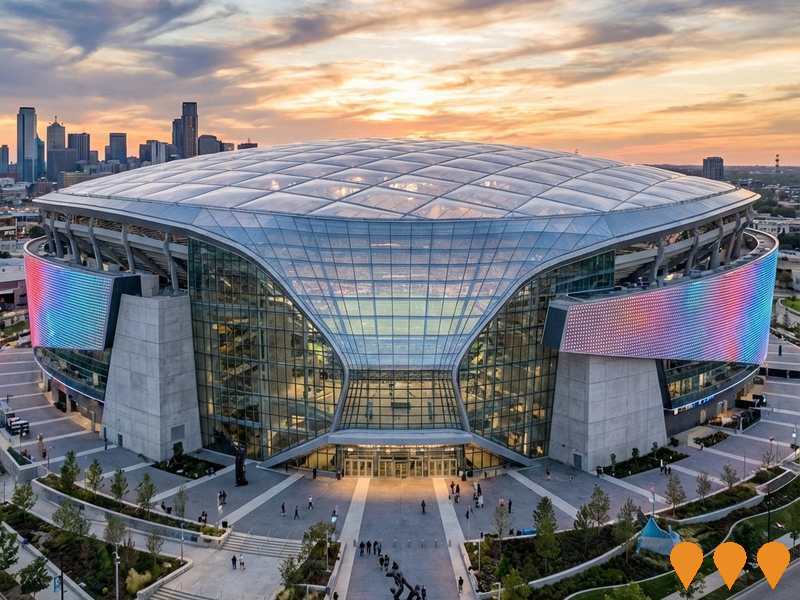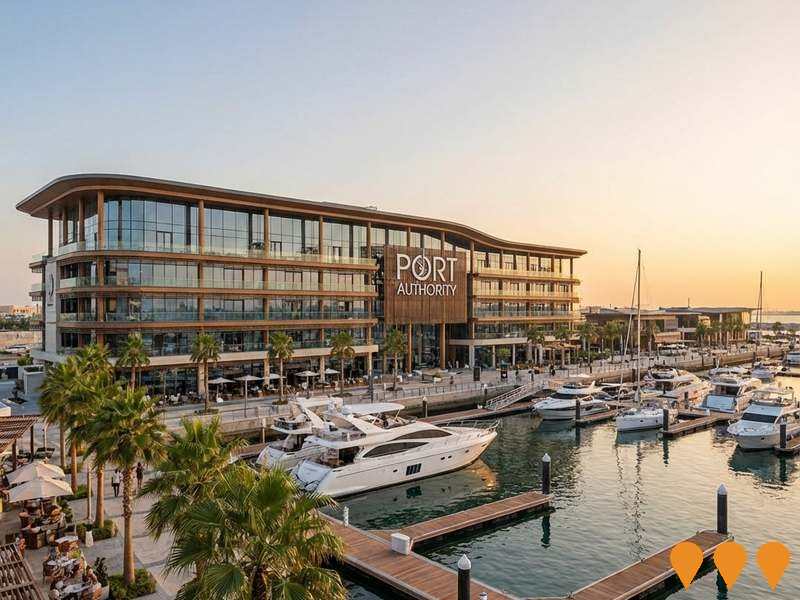Chart Color Schemes
est. as @ -- *
ABS ERP | -- people | --
2021 Census | -- people
Sales Activity
Curious about local property values? Filter the chart to assess the volume and appreciation (including resales) trends and regional comparisons, or scroll to the map below view this information at an individual property level.
Find a Recent Sale
Sales Detail
Population
An assessment of population growth drivers in Kadina reveals an overall ranking slightly below national averages considering recent, and medium term trends
Kadina's population was approximately 5,725 as of August 2025. This figure represents an increase of 311 people, a 5.7% growth from the 2021 Census which reported a population of 5,414. The change is inferred from ABS's estimated resident population of 5,721 in June 2024 and an additional 22 validated new addresses since the census date. This results in a population density ratio of 14.5 persons per square kilometer. Kadina's growth rate of 5.7% since the census is comparable to its SA4 region's growth rate of 5.8%. Interstate migration contributed approximately 71.6% of overall population gains during recent periods, with other factors such as natural growth and overseas migration also being positive contributors.
AreaSearch uses ABS/Geoscience Australia projections for each SA2 area, released in 2024 with a base year of 2022. For areas not covered by this data and years post-2032, the SA State Government's Regional/LGA projections are adopted with adjustments made using weighted aggregation methods from LGA to SA2 levels. Based on projected demographic shifts, Kadina is expected to increase by approximately 549 persons to reach 2041, reflecting a total increase of 9.5% over the 17-year period.
Frequently Asked Questions - Population
Development
AreaSearch analysis of residential development drivers sees Kadina recording a relatively average level of approval activity when compared to local markets analysed countrywide
Kadina has recorded approximately 25 residential properties granted approval each year. Over the past five financial years, from FY-21 to FY-25, a total of 129 homes were approved, with an additional 4 approved so far in FY-26. On average, 1.8 new residents per dwelling have been added annually over these years.
This balance between supply and demand supports stable market conditions, with new properties constructed at an average value of $389,000. In the current financial year, there have been $3.1 million in commercial approvals, indicating limited focus on commercial development compared to residential. Compared to the rest of South Australia, Kadina records significantly lower building activity, at 57.0% below the regional average per person. This limited new supply generally supports stronger demand and values for established properties.
Recent construction comprises 95.0% detached dwellings and 5.0% townhouses or apartments, maintaining the area's traditional low density character with a focus on family homes appealing to those seeking space. The location has approximately 254 people per dwelling approval, indicating a low density market. Looking ahead, Kadina is expected to grow by 545 residents through to 2041. Based on current development patterns, new housing supply should readily meet demand, offering good conditions for buyers and potentially facilitating population growth beyond current projections.
Frequently Asked Questions - Development
Infrastructure
Kadina has emerging levels of nearby infrastructure activity, ranking in the 38thth percentile nationally
Changes in local infrastructure significantly affect an area's performance. AreaSearch has identified 12 projects that could impact the region. Notable projects include Kadina Central Expansion, Kadina Wastewater Lagoons Relining, Daddow Court and Abbott Drive Residential Development, and Kadina Town Hall Restoration. The following list details those most likely to be relevant.
Professional plan users can use the search below to filter and access additional projects.
INFRASTRUCTURE SEARCH
 Denotes AI-based impression for illustrative purposes only, not to be taken as definitive under any circumstances. Please follow links and conduct other investigations from the project's source for actual imagery. Developers and project owners wishing us to use original imagery please Contact Us and we will do so.
Denotes AI-based impression for illustrative purposes only, not to be taken as definitive under any circumstances. Please follow links and conduct other investigations from the project's source for actual imagery. Developers and project owners wishing us to use original imagery please Contact Us and we will do so.
Frequently Asked Questions - Infrastructure
Northern Water
Northern Water is an extensive water infrastructure and supply project aimed at securing an alternate, sustainable, climate-independent water source for eastern Eyre Peninsula, Upper Spencer Gulf, and the Far North of South Australia. The project supports current and future growth in the region and reduces reliance on River Murray, Great Artesian Basin, and local groundwater resources, servicing users such as mining operations, industry (including hydrogen), Department of Defence, remote communities, pastoralists, and SA Water. Key features include a 130-260 ML/day seawater reverse osmosis desalination plant, water intake and outlet pipes, a ~600km main trunk pipeline, lateral connections, six pump stations, six water storage areas, electricity transmission infrastructure, communications towers, and ancillary services.

Kadina Town Hall Restoration
Restoration of the heritage-listed Kadina Town Hall to address structural and safety issues, including roof and interior works. The hall officially reopened to the public in June 2019 and is now back in regular community use and hosts Council meetings.

Kadina Central Expansion
Kadina Central Expansion is a major masterplanned community on the eastern side of Kadina, adding more than 115 new homes alongside a 14 home retirement village, a gated community with specialised disability housing, a 1000sqm medical centre, and a 112 place childcare centre. The project also features a smart park with public Wi Fi, wireless device charging and other smart city elements to support the wider Copper Coast community. The expansion has council approval and is progressing through staged construction in partnership with Leipzig Australia.

Kadina Wastewater Lagoons Relining
Council project to reline two wastewater treatment lagoons (Lagoons 2 and 3) at Kadina to meet EPA compliance requirements. Works included dewatering, shaping and compacting, adding a sand layer, installing HDPE plastic liners, and pressure testing. As of mid-June 2025 both lagoons are lined and pressure tested, with as-constructed levels and engineering approval pending.

Wallaroo Shores Masterplanned Community (Aspen Group Stages)
Aspen Group acquired the remaining stages of the Wallaroo Shores masterplanned community in September 2025. The new concept masterplan, agreed with the Copper Coast Council, comprises over 300 sites including approximately 200 lifestyle land lease sites, residential build-to-rent (BTR) units, townhouses, residential land lots, and a commercial and retail precinct. Aspen will seek formal development approval after the transaction settles. The original developer, Monopoly Property Group, had an initial $220 million plan for a total of 656 dwellings, a resort, shopping centre and lifestyle village, but that development stalled following the collapse of the initial builder in 2023.

Kadina Northeastern Fringe Rezoning (Daddow Court / Abbott Drive)
Rezoning of approximately 28 hectares of farming land at Lot 300 Daddow Court and Abbott Drive on Kadina's north eastern fringe from Deferred Urban to Neighbourhood to enable around 227 low density residential allotments with associated internal roads, open space and infrastructure. The code amendment has been adopted by the Minister, allowing the proponent Lasopail Pty Ltd to progress the next stage of planning and prepare a development application.

Kulpara Quarry Operations
Operational hard rock quarry supplying aggregates, sands and road base across Yorke Peninsula, Northern Adelaide and the Mid North. The site operates under Extractive Minerals Leases EML 6074, EML 6179 and EML 6180, with extended operating hours approved in 2022 to meet major project demand. Products service civil, construction and domestic markets via Hallett Group/Hallett Resources.
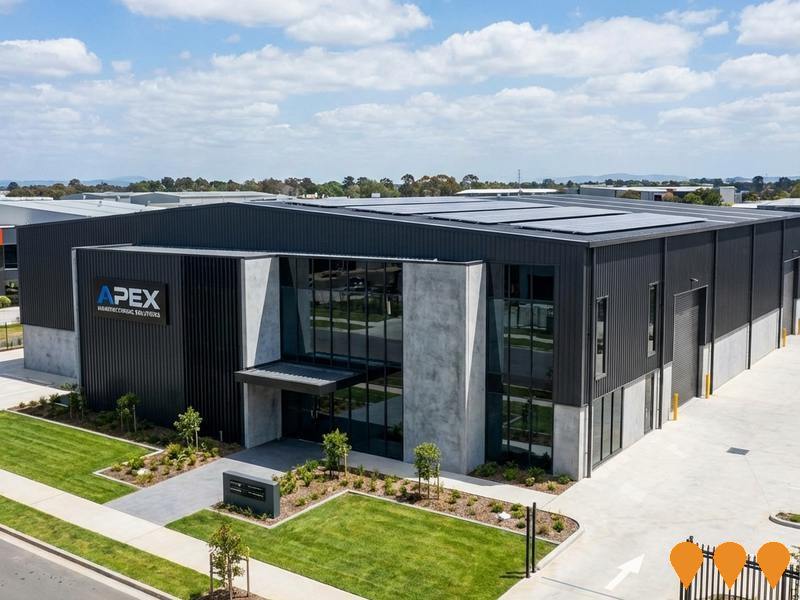
Wallaroo Roads Rehabilitation
Pavement rehabilitation and resurfacing work on multiple roads within Wallaroo township, jointly funded by the State Government and Copper Coast Council, to improve safety, access, and road amenity for all users, enhancing transport efficiency and sustainability. The $5.2 million project commenced in September 2025 and is expected to be completed in mid-2026.

Employment
Employment conditions in Kadina face significant challenges, ranking among the bottom 10% of areas assessed nationally
Kadina's workforce is balanced across white and blue-collar jobs with diverse sector representation. The unemployment rate in June 2025 was 7.4%.
In Kadina, 2,405 residents were employed while the unemployment rate was 2.8% higher than Rest of SA's rate of 4.6%. Workforce participation was similar to Rest of SA's 54.1%. Employment was concentrated in health care & social assistance, retail trade, and education & training. Retail trade stood out with employment levels at 1.4 times the regional average.
Agriculture, forestry & fishing was under-represented, with only 8.1% of Kadina's workforce compared to 14.5% in Rest of SA. Many residents commute elsewhere for work based on Census data. Between June 2024 and June 2025, labour force levels increased by 0.2% while employment declined by 1.4%, causing the unemployment rate to rise by 1.5 percentage points. Jobs and Skills Australia's national employment forecasts from May 2025 project national employment growth of 6.6% over five years and 13.7% over ten years, with varying rates across sectors. Applying these projections to Kadina's employment mix suggests local growth of approximately 5.9% over five years and 12.8% over ten years.
Frequently Asked Questions - Employment
Income
The area's income levels rank in the lower 15% nationally based on AreaSearch comparative data
AreaSearch's latest postcode level ATO data for financial year 2022 shows Kadina's median income among taxpayers is $46,097. The average income in Kadina during this period was $54,710. Both figures are below the national averages. Rest of SA had a median income of $46,889 and an average of $56,582 in 2022. Based on Wage Price Index growth of 12.83% since financial year 2022, estimated current incomes for Kadina are approximately $52,011 (median) and $61,729 (average) as of September 2025. The 2021 Census figures indicate that household, family, and personal incomes in Kadina all fall between the 10th and 12th percentiles nationally. Income distribution shows that 29.3% of individuals in Kadina earn between $1,500 - $2,999, aligning with the surrounding region where this cohort represents 27.5%. Despite modest housing costs allowing for 87.2% income retention, total disposable income ranks at just the 14th percentile nationally.
Frequently Asked Questions - Income
Housing
Kadina is characterized by a predominantly suburban housing profile, with a higher proportion of rental properties than the broader region
Kadina's dwelling structures, as recorded in the latest Census, consisted of 93.9% houses and 6.1% other dwellings such as semi-detached homes, apartments, and 'other' dwellings. This is comparable to Non-Metro SA's figures of 93.3% houses and 6.7% other dwellings. Home ownership in Kadina stood at 42.2%, with the remaining dwellings either mortgaged (32.8%) or rented (25.0%). The median monthly mortgage repayment was $1,127, exceeding Non-Metro SA's average of $1,083. Meanwhile, the median weekly rent in Kadina was $250, higher than Non-Metro SA's figure of $230. Nationally, Kadina's mortgage repayments were significantly lower at $1,127 compared to Australia's average of $1,863, and rents were substantially below the national average of $375.
Frequently Asked Questions - Housing
Household Composition
Kadina has a typical household mix, with a higher-than-average median household size
Family households constitute 68.0% of all households, including 23.0% couples with children, 32.0% couples without children, and 12.1% single parent families. Non-family households account for the remaining 32.0%, with lone person households at 29.6% and group households comprising 2.6%. The median household size is 2.3 people, larger than the Rest of SA average of 2.1.
Frequently Asked Questions - Households
Local Schools & Education
Kadina faces educational challenges, with performance metrics placing it in the bottom quartile of areas assessed nationally
The area has university qualification rates at 10.9%, substantially lower than the Australian average of 30.4%. This presents both a challenge and an opportunity for targeted educational initiatives. Bachelor degrees are most common at 8.2%, followed by graduate diplomas (1.8%) and postgraduate qualifications (0.9%). Trade and technical skills are prominent, with 39.8% of residents aged 15+ holding vocational credentials – advanced diplomas (8.2%) and certificates (31.6%).
Educational participation is high at 26.2%, including 11.2% in primary education, 8.6% in secondary education, and 1.5% pursuing tertiary education. Kadina's 3 schools have a combined enrollment of 1,616 students. The educational mix includes 1 primary school and 2 K-12 schools. The area functions as an education hub with 28.2 school places per 100 residents, significantly above the regional average of 12.2, attracting students from surrounding communities.
Frequently Asked Questions - Education
Schools Detail
Nearby Services & Amenities
Transport
No public transport data available for this catchment area.
Frequently Asked Questions - Transport
Transport Stops Detail
Health
Health performance in Kadina is a key challenge with a range of health conditions having marked impacts on both younger and older age cohorts
Kadina faces significant health challenges with various conditions affecting both younger and older residents. Approximately 47% (~2,702 people) have private health cover, lower than the national average of 55.3%.
The most prevalent medical conditions are arthritis (10.5%) and asthma (10.0%). About 59.4% report no medical ailments, compared to 56.0% in Rest of SA. Around 26.8% (~1,536 people) are aged 65 and over, lower than the 36.2% in Rest of SA. Health outcomes among seniors show some challenges but perform better than the general population in health metrics.
Frequently Asked Questions - Health
Cultural Diversity
The latest Census data sees Kadina placing among the least culturally diverse areas in the country when compared across a range of language and cultural background related metrics
Kadina's cultural diversity was found to be below average, with 92.5% of its population being Australian citizens, 92.6% born in Australia, and 98.1% speaking English only at home. The dominant religion in Kadina is Christianity, comprising 41.7% of the population, compared to 48.3% across the Rest of SA. Regarding ancestry (country of birth of parents), the top three groups represented in Kadina are Australian (37.5%), English (34.2%), and German (6.5%).
Notably, Australian Aboriginal is overrepresented at 3.2%, compared to the regional average of 2.6%, while Dutch representation is also higher at 1.4% versus 1.2%.
Frequently Asked Questions - Diversity
Age
Kadina hosts an older demographic, ranking in the top quartile nationwide
Kadina's median age is 45, which is slightly below Rest of SA's figure of 47 but notably higher than Australia's 38 years. Comparing Kadina with Rest of SA, the 85+ cohort is significantly over-represented at 4.2%, while individuals aged 25-34 are under-represented at 9.5%. Between 2021 and present, the population share of those aged 65 to 74 has increased from 12.9% to 13.9%. Conversely, the proportion of people aged 45 to 54 has decreased from 12.1% to 10.6%, and the 25 to 34 age group has dropped from 10.5% to 9.5%. By 2041, demographic projections indicate substantial shifts in Kadina's age structure. The number of individuals aged 85+ is projected to rise significantly, increasing by 233 people (97%) from 241 to 475. Residents aged 65 and above will contribute 68% of population growth, highlighting demographic aging trends. Conversely, populations in the 0 to 4 and 5 to 14 age cohorts are projected to decline.
